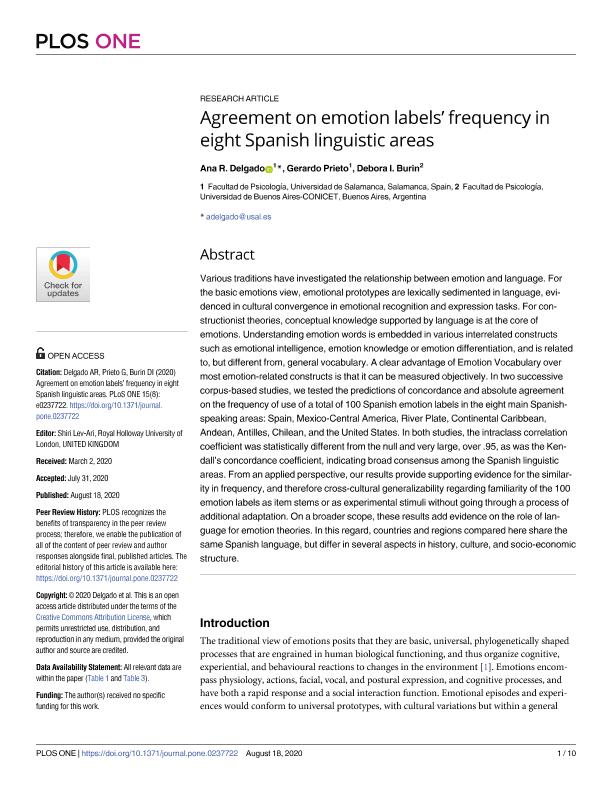Mostrar el registro sencillo del ítem
dc.contributor.author
Delgado, Ana R.
dc.contributor.author
Prieto, Gerardo
dc.contributor.author
Burin, Debora Ines

dc.date.available
2022-06-28T16:01:55Z
dc.date.issued
2020-08
dc.identifier.citation
Delgado, Ana R.; Prieto, Gerardo; Burin, Debora Ines; Agreement on emotion labels’ frequency in eight Spanish linguistic areas; Public Library of Science; Plos One; 15; 8; 8-2020; 1-10
dc.identifier.issn
1932-6203
dc.identifier.uri
http://hdl.handle.net/11336/160649
dc.description.abstract
Various traditions have investigated the relationship between emotion and language. For the basic emotions view, emotional prototypes are lexically sedimented in language, evidenced in cultural convergence in emotional recognition and expression tasks. For constructionist theories, conceptual knowledge supported by language is at the core of emotions. Understanding emotion words is embedded in various interrelated constructs such asemotional intelligence, emotion knowledge or emotion differentiation, and is related to, but different from, general vocabulary. A clear advantage of Emotion Vocabulary over most emotion-related constructs is that it can be measured objectively. In two successive corpus-based studies, we tested the predictions of concordance and absolute agreement on the frequency of use of a total of 100 Spanish emotion labels in the eight main Spanishspeaking areas: Spain, Mexico-Central America, River Plate, Continental Caribbean, Andean, Antilles, Chilean, and the United States. In both studies, the intraclass correlation coefficient was statistically different from the null and very large, over .95, as was the Kendall’s concordance coefficient, indicating broad consensus among the Spanish linguistic areas. From an applied perspective, our results provide supporting evidence for the similarity in frequency, and therefore cross-cultural generalizability regarding familiarity of the 100 emotion labels as item stems or as experimental stimuli without going through a process of additional adaptation. On a broader scope, these results add evidence on the role of language for emotion theories. In this regard, countries and regions compared here share the sameSpanish language, but differ in several aspects in history, culture, and socio-economic structure.
dc.format
application/pdf
dc.language.iso
eng
dc.publisher
Public Library of Science

dc.rights
info:eu-repo/semantics/openAccess
dc.rights.uri
https://creativecommons.org/licenses/by/2.5/ar/
dc.subject
EMOTION
dc.subject
EMOTION WORDS
dc.subject
CULTURAL DIVERSITY
dc.subject
WORD FREQUENCY
dc.subject.classification
Otras Psicología

dc.subject.classification
Psicología

dc.subject.classification
CIENCIAS SOCIALES

dc.title
Agreement on emotion labels’ frequency in eight Spanish linguistic areas
dc.type
info:eu-repo/semantics/article
dc.type
info:ar-repo/semantics/artículo
dc.type
info:eu-repo/semantics/publishedVersion
dc.date.updated
2022-06-24T17:23:41Z
dc.journal.volume
15
dc.journal.number
8
dc.journal.pagination
1-10
dc.journal.pais
Estados Unidos

dc.journal.ciudad
California
dc.description.fil
Fil: Delgado, Ana R.. Universidad de Salamanca; España
dc.description.fil
Fil: Prieto, Gerardo. Universidad de Salamanca; España
dc.description.fil
Fil: Burin, Debora Ines. Consejo Nacional de Investigaciones Científicas y Técnicas; Argentina. Universidad de Buenos Aires. Facultad de Psicología; Argentina
dc.journal.title
Plos One

dc.relation.alternativeid
info:eu-repo/semantics/altIdentifier/url/https://journals.plos.org/plosone/article?id=10.1371/journal.pone.0237722
dc.relation.alternativeid
info:eu-repo/semantics/altIdentifier/doi/http://dx.doi.org/10.1371/journal.pone.0237722
Archivos asociados
